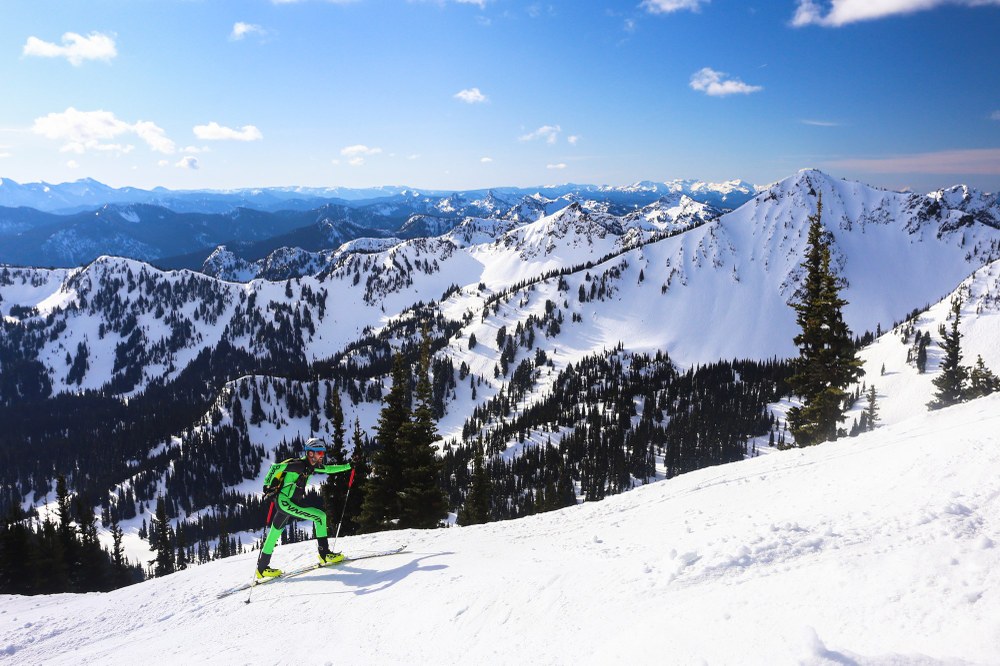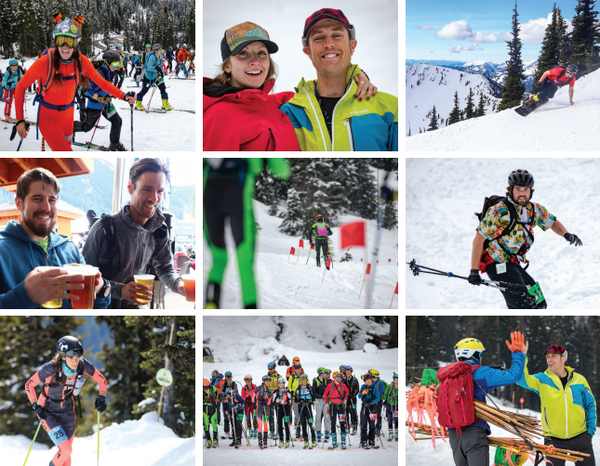
It must be nice, being a mountain goat. To move through the mountains with speed and grace, inspiring fear, respect, and admiration in all who lay eyes on you. With gravitydefying climbing skills and a legendary beard, mountain goats are untouchable.
If you aspire to mountain goat-level greatness, then I have a sport with your name written all over it. All you have to do is find yourself a set of fear-inspiring lycra, lighter-thanlightweight skis, and a higher-than-high ability to suffer.
Just kidding. Spandex suits are not required (only encouraged).
The sport I’m referencing is ski mountaineering, or skimo for short. It’s sort of a hybrid between ultrarunning and backcountry skiing, where the goal is moving fast and light to cover great distances and elevation in the mountains. In the Pacific Northwest, skimoers Jason Dorais and Tom Goth recently broke the fastest known time on Mt. Rainier. They climbed from Paradise to the summit of Mt. Rainier and skied back down in just under three and a half hours in May 2019. Their feat is the epitome of skimo.
Skimo is functionally the same as backcountry skiing. Backcountry skiers use gear – also called a ”set up” – similar to traditional downhill ski equipment you’d find in the resort, but with added features to give the user the ability to climb uphill with skis and boots on their feet. Backcountry boots have a walk mode, providing a much larger range of motion than traditional alpine boots, and bindings are equipped with a climbing mode where only the toe piece is attached and the heel is free to move up and down. For grip, skins are placed on the bottom of the skis. They feel a lot like horsehair, smooth in one direction and grippy in the other, providing good traction when climbing on moderate level slopes. When it’s time to descend, the skins are removed and the boots and bindings are transitioned into ski mode. This gear allows the skier to explore and enjoy areas not accessible by chairlifts.
Skimoers take backcountry skiing a step further. Their gear is designed for the uphill, meaning two skis, boots, and a set of skins weighs roughly the same as one of my regular ski boots. The weight savings comes at a cost though, namely in performance on the ski down. But that’s okay. Your average skimoer spends 90% of their time going up, and 10% of their time trying not to wipe out on the way down.
Like many other winter activities, skimo is a group activity. Aspiring skimoers will discover a vibrant, passionate, welcoming, encouraging, community that is yes, sometimes a little competitive. Which makes sense. You don’t generally find mountain goats on their own either, do you?
One way that people get into skimo, at least around here, is through the annual Patrol Race hosted by Meany Lodge. In the 1920s, adventurous Mountaineers scouted an 18+ mile ski route between our two mountain lodges (the Snoqualmie Lodge, at Snoqualmie Pass, at Meany Lodge, near Stampede Pass). In 1930, they inaugurated a race over this route. This race was the first of its kind in North America, and it ran for 14 years before falling out of favor during World War II. Volunteers revived the Patrol Race in 2014.
One of the Patrol Race’s early fans was Richard “Dick” Kresser. He was first introduced to The Mountaineers by Gavin Woody, past-President of The Mountaineers Board of Directors, when they met through ultrarunning. Gavin and Dick are both military veterans, and they quickly bonded over their shared ability to stay awake during multi-day races. Gavin invited Dick to be his partner a few years ago to support a Mountaineers fundraising traverse of the Tatoosh Range, and, on that trip Dick – who is on Stevens Pass Pro Ski Patrol in addition to being a trail-runner and endurance athlete – learned about the Patrol Race. He signed up.
After discovering an appreciation for skimo races as a competitor in the Patrol Race, Dick was looking for more opportunities like it, but found few. “I really wanted to see more stuff like [the Patrol Race]. Not just to be able to compete and have that place for people to compete with each other, but also to form that community and have that after-race party where everyone is still high on the adrenaline pumping through their veins, laughing and having a really good time.” The idea for Snow Goat Skimo was born.
The need for organized skimo races was large. “I was like well, we need these events here in Washington, and we don’t have any really,” said Maudie Jordan, who together with Dick cofounded Snow Goat. “That’s kind of what set the track for us wanting to do this together.”
As life and adventure partners with a love of skiing and community, Maudie and Dick found themselves well-equipped to bring more races to the Pacific Northwest. They both have backgrounds in event organization with communities that share the same masochistic and adrenaline-loving genes as ski-mountaineers: trail running and mountain biking. These communities also happen to have plenty of skimoers in their midst. Snow Goat’s website offers a hypothesis to explain the crossover. “Skimo has been growing as large numbers of cyclists, runners, and others find it a great way to stay in shape in the winter. They quickly realize it might be more fun than their main summertime sport!”
 There’s something for everybody at Snow Goat events. Founders Maudie Jordan and Dick Kresser, at top-center. All photos courtesy of Snow Goat Skimo.
There’s something for everybody at Snow Goat events. Founders Maudie Jordan and Dick Kresser, at top-center. All photos courtesy of Snow Goat Skimo.
While Dick was already subscribed to the winter lifestyle, Maudie is a relative newcomer to the sport of skiing. But she fell in love quickly. Her website bio cites a passion for sharing her newfound love of skiing with others, just in case they might love it too.
Snow Goat is in its second season as a Pacific Northwest organizer of ski-mountaineering races. After a very successful first season, Snow Goat released its 2020 race calendar with events at Crystal Mountain, Loup Loup (outside of Winthrop), and Snoqualmie. It’s a dream come true for Dick, whose website bio states that “since a few of his favorite things are skiing, going uphill as quickly as he can, and putting on events, he figured he'd start a few more skimo races in the Pacific Northwest.”
The skimo courses often wind through mountainous areas, much like how a marathon might wind through city streets. Different sections offer different challenges, with similar skills needed for all races. The courses generally feature some bootpacking, where racers carry their skis to ascend a steep section, multiple transition points from skinning to skiing, and plenty of uphill travel on skis. Races can take place inbounds at ski resorts or in the backcountry, and sometimes it’s a mix of both.
For those brave souls who sign up to compete, racers have different categories to choose from. For example, in the Loup Loup race competitors can compete in the “recreation” league within a one-hour time window, or in the “race” category within a four-hour time window. In both, the goal is to get as many laps as possible along the boundary edge of Loup Loup, ascending roughly 1,100 vertical feet each race. The 2019 winner managed 14 laps, covering roughly 28 miles and 16,000 vertical feet. Mountain goats may even struggle to do that in four hours.
Throughout their first season of races, Dick and Maudie received plenty of positive feedback to reinforce what they were doing. It seemed that a set of organized events was just what the community had been waiting for. “Right now, there’s not that many backcountry ski events for people to meet new touring partners, make new friends, and reconnect with friends,” Dick said. “People naturally want to challenge themselves and create those bonds after an event.”
Dick sees the hunger for these events not just from skimo racers. Lots of excitement is coming from the broader ski community as well. “There’s the guys in lycra and then there’s the people out there who have no aspirations to race, who are just looking to go out and have a really good time and challenge themselves,” Dick said. “Everyone is racing for a different reason and everyone is out there having a fun time challenging themselves.”
As much as these races are about the competition, they’re also about meeting new friends, finding new skiing partners, and having a good time along the way. “It’s primal really, going out there and exerting your body and then coming together and sharing stories,” Maudie said. “I think that creates a bond and connection among people, and honestly has for centuries.”
If Dick and Maudie have a goal with Snow Goat Skimo, it’s to build community, and provide people with the opportunity to share what they love with others. “I just want to see other people have the opportunity to do things like this, get into it, and create a community,” Maudie said.
When mountain goats are born, they’re given little time to learn their way in the mountains. Within minutes they’re on their feet, moving with agility, doing their best to keep up in their little herd. Perhaps Maudie and Dick are right. Moving through the mountains, sharing it with others, and adding a hint of competition is more natural than we might think.
This article originally appeared in our Winter 2020 issue of Mountaineer Magazine. To view the original article in magazine form and read more stories from our publication, click here.
 Trevor Dickie
Trevor Dickie